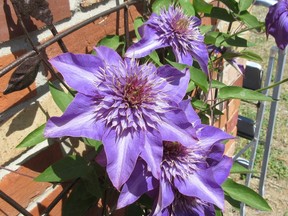They can be quite easily brought back to full flowering

Reviews and recommendations are unbiased and products are independently selected. Postmedia may earn an affiliate commission from purchases made through links on this page.
Article content
Q. My spring-flowering clematis vines, which I believe are Clematis montana, have in recent years produced fewer and fewer of their lovely pink blooms. The stems are quite woody. Is there a way of bringing the vines back to full bloom or should they be replaced?
Advertisement 2
Article content
A. There is no need to replace them. They can be quite easily restored to full flowering — by extreme pruning. Wait to do this until the usual bloom period is over, in early summer.
Article content
Here’s what I did with my C. montana vines, which I planted years ago at the latticework corner bases of a simple gazebo-like structure in the centre of the back garden. The vines had grown up the sides and over the top, to form a roof of pink flowers every May.
In the past few years flowering had become increasingly sparse. The oldest stems had turned woody and looked shredded.
One early summer day two years ago, when a friend was helping out in the garden, we appraised the flagging clematis vines together. Noting the substantial numbers of rapidly growing new, green shoots among the old, woody ones, I decided to take the extreme action of renewing the vines completely.
Advertisement 3
Article content
We removed all the old growth, thinned the many fresh, young stems to leave the strongest, and began training them up the structure corners and over the slats across the top.
The new stems began producing a scattering of bloom in the spring of the following year.
The removal and disposal of all the old stems was a big job. I was more than glad to have help. My friend used her long-handled clippers to quickly chop the stems into fine pieces for speedier decomposition in the compost.
Except when this extreme pruning becomes necessary, spring-flowering clematis vines like C. montana are routinely pruned only to remove dead or weak stems. The pruning is done at the end of the flowering period.
Recommended from Editorial
Article content





